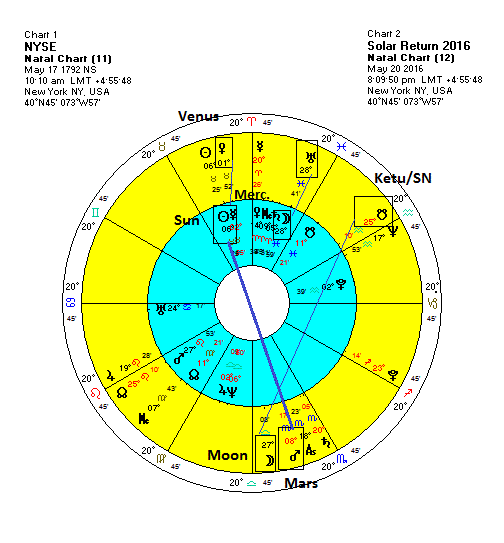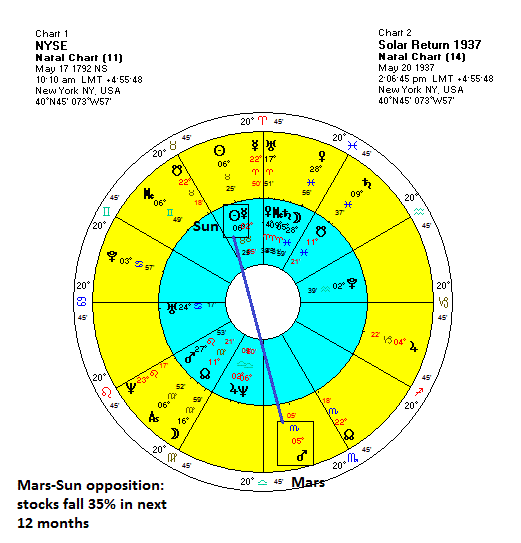 (17 May 2016)
Today is a day of special significance in financial astrology as the
New York Stock Exchange turns 224 years old. The NYSE was founded on
May 17, 1792, most likely around 10 a.m., although the exact time of its
origin is a matter of some debate. The birthday of the world's biggest
and most venerable stock exchange provides a valuable window on the
financial outlook for next 12 months. According to the basic principles
of astrology, the return of the Sun to its position at the time of birth
is said to contain clues for what may happen in the coming year. This
idea holds true for both individuals and collective entities such as the
NYSE. It is also worth noting that due to the procession of the
equinoxes, the Sun does not actually return to its natal position of 6
degrees of sidereal Taurus until May 20th.
(17 May 2016)
Today is a day of special significance in financial astrology as the
New York Stock Exchange turns 224 years old. The NYSE was founded on
May 17, 1792, most likely around 10 a.m., although the exact time of its
origin is a matter of some debate. The birthday of the world's biggest
and most venerable stock exchange provides a valuable window on the
financial outlook for next 12 months. According to the basic principles
of astrology, the return of the Sun to its position at the time of birth
is said to contain clues for what may happen in the coming year. This
idea holds true for both individuals and collective entities such as the
NYSE. It is also worth noting that due to the procession of the
equinoxes, the Sun does not actually return to its natal position of 6
degrees of sidereal Taurus until May 20th. The financial significance of the Solar Return or Vashphal chart emerges when it is overlaid with the natal chart. Significant planetary placements and alignments determine if gains or losses are more likely in the coming year by the next birthday on 17 May 2017. The core principle of financial astrology is that if malefic planets like Mars and Saturn form closer alignments then declines are more likely whereas benefic planet alignments will tend to produce gains. Precedence is usually granted to the Moon, Sun and Ascendant in this regard so that the planetary alignments involving these points will have a larger influence on the final outcome.
At the time of last year's NYSE birthday, I suggested that US stocks were likely to decline in the subsequent 12 months since Saturn was very closely aligned with the Sun by 90-degree square aspect.
The bottom line here is that Saturn-Sun
aspects that occur near the Solar Return chart on May 17th (or rather
the 21st thanks to the precession of the equinoxes) will tend to have a
depressing effect on the stock market. While it is only one factor, I
would think that it could well outweigh other positive factors in the
chart. This is another indication that stocks are likely to suffer a
decline over the coming 12 months.
Stocks have indeed declined in the intervening 12-month period since May 17, 2015. The blue-chip Dow Jones Industrial Average has only fallen 3% since that time, although the broader and arguably more representative NYSE Composite Index is down 8% since last May. Interestingly, the NYSE Composite peaked that very month and has been trending lower ever since, albeit with much deeper declines in August of last year and January-February this year. It looks like Saturn had the final say there.
This year's Solar Return (SR) chart looks challenging again. Like last year's chart, however, there are some positive alignments. Venus (1 Taurus) is conjunct natal Mercury (2 Taurus). This is quite a good pairing as both planets are considered benefic. But Venus and Mercury tend to be lesser factors in shaping the overall outcome. Since we have many planets across two charts, the number of possible aspects and alignments quickly multiply and become unwieldy for analytical purposes. In my experience, alignments involving the Sun and Moon may take precedence. We should omit consideration of the Ascendant here since the exact birth time of the NYSE is uncertain.

Uranus (28 Pisces) is exactly conjunct the Moon in this year's SR chart. Uranus often coincides with intensity, unpredictability and sudden changes. This Uranus-Moon conjunction suggests this coming year will feature a significant amount of big moves in the markets -- even in both directions -- as the Uranus influence is actually neutral. By itself, it is not necessarily correlated with gains or declines. The Uranus influence here does suggest that the stock market may be in the news more than usual.
This theme of unpredictability and even instability is echoed in the SR chart as the Moon (27 Libra) is closely aspected by Ketu (25 Aquarius). Ketu has a similar effect as Uranus in that it disrupts the status quo and undermines fixed structures.
The more difficult alignment here is that retrograde Mars (8 Scorpio) is in a close opposition aspect with the Sun (6 Taurus). This is a negative influence which may well cast the deciding planetary vote for this chart. True, we don't know if there may be offsetting positive influences on the Ascendant (e.g. a Jupiter conjunction). But based on this Solar Return chart, I would the US stock market is likely to decline over the next 12 months. Given the global dominance of the NYSE, this augurs poorly for most world stock markets also.

The last time Mars was in a similar location in Scorpio opposite the Sun at the time of the May 17th Solar Return was in 1937. Mars was also retrograde at 5 degrees of Scorpio that year on May 20th -- including the three-day correction for procession. 1937 is a well-known year in stock market history since it marked the first major bear market since the Depression in the early 1930s. The markets had bottomed in 1932 and had been recovering fairly well for several years.
But that all changed in 1937 as stocks peaked in February and then fell through the rest of the year. In May 1937, the Dow stood at 175 and would eventually bottom in March 1938 near 100. By May 1938 at the time of the next NYSE Solar Return, it had only slightly recovered to 110. The stock market had declined 35% during that May-to-May SR period. While we could make an argument for the importance of other factors in that 1937 SR chart, the Mars placement does stand out as the most obviously bearish.
History may not necessarily repeat itself during this next SR but the placement of Mars just a few degrees away from its fateful placement in May 1937 is a possible warning of increased risk of declines.
Weekly Market Forecast
After slipping a bit last week, stocks recovered their footing Monday. The Dow finished at 17,710 while India's Sensex posted a modest gain to move above 25,600. It is up again in early trading in the Tuesday session. In last week's market forecast, I had expected fairly choppy trading given the mix of aspects through last week. I thought we might have seen a little more late week upside last week although those gains appear to have manifested early this week so far.
As the Sun enters Taurus this week and therefore sets up its opposition to Mars (!) and eventually Saturn, I would be surprised if stocks rose much further this week. The late week looks more negative perhaps as the Sun-Mars opposition is closest at that time.
For more details and analysis on market trends for this week, this month and this year, please check out my weekly MVA Investor Newsletter. The newsletter includes discussion of US and Indian stock markets, as well as gold, oil and major currencies.